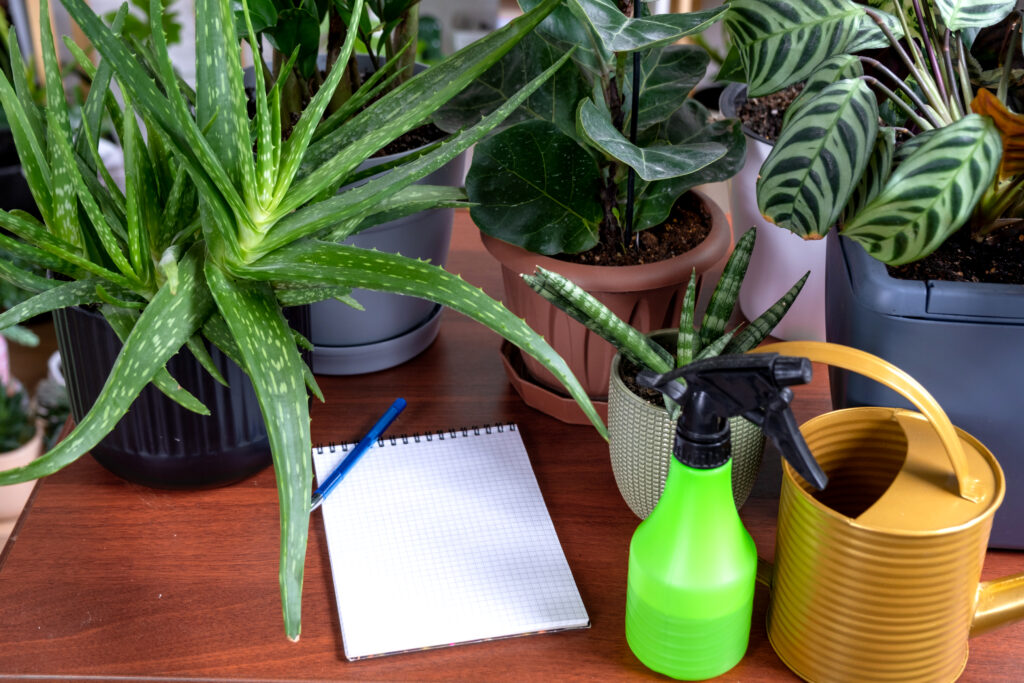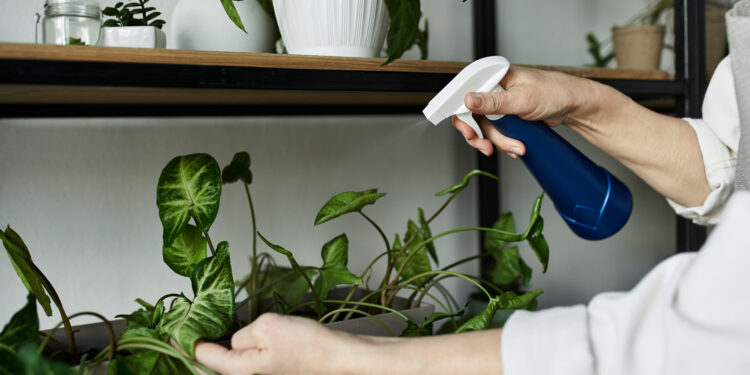Summer in the UK means three things: spontaneous barbecues, a national obsession with fans, and a suspicious uptick in houseplant pests. Dealing with houseplant pests during humid weather is becoming a rite of passage for plant parents up and down the country. From fungus gnats that hover like tiny helicopters to mealybugs that appear out of nowhere like unwanted in-laws, warm, moist air creates the ideal breeding ground for an infestation.
If you’ve noticed your monstera looking more miserable than majestic, or your spider plant’s leaves curling into themselves like introverts at a party, it’s probably not just the heat. It’s the pests. The sneaky, sap-sucking kind.
Here’s everything you need to know about why your flat feels like Club Tropicana for bugs, and how to give them the boot. Warm, humid air turns your home into a pest paradise, inviting fungus gnats, mealybugs, and other clingy critters. But with a few smart moves, you can reclaim your leafy space and show these bugs the door.
Why Humidity Attracts Houseplant Pests?
Before we get into sprays and natural remedies, it’s worth understanding why humid weather turns your home into a bug Airbnb.
Humidity creates the perfect microclimate for pests and mould. When warm air holds more moisture, your plant soil takes longer to dry out. That’s excellent news for fungus gnats and other pests that lay eggs in moist compost. Combine that with still air and a lack of predators (unlike outside), and your cosy indoor garden becomes paradise for tiny invaders.
Common problems during the UK’s warm months include:
- Overwatering due to slower evaporation
- Reduced airflow in closed windows/flats
- Increased reproduction rates of common pests
Now let’s meet the usual suspects, and how to outsmart them.
- Fungus Gnats: The Buzzkill of Summer
Symptoms: Tiny black flies hovering around the soil or base of your plants. They love moisture and decaying matter.
Why they thrive in humidity: Warm, wet soil is their nursery. Females lay hundreds of eggs in moist compost. The larvae then feed on plant roots—especially in seedlings.
How to treat fungus gnats:
- Let soil dry out: This is the quickest way to disrupt the life cycle. Gnats can’t breed in dry conditions.
- Bottom watering: Water plants from below so the topsoil stays dry.
- Sticky traps: Yellow sticky traps are affordable and effective. They catch adults and help monitor populations.
- Biological warfare: Consider introducing nematodes (like Steinernema feltiae), a natural predator of gnat larvae.
- Cinnamon: Sprinkle cinnamon on the soil. It’s a natural antifungal and gnat deterrent.
Prevention tips:
- Always check for gnats when buying new plants or bags of compost.
- Use a soil mix with good drainage.
- Consider a layer of sand or fine gravel on top of the compost to keep gnats from laying eggs.
2. Mealybugs: The Cotton Wool Imposters
Symptoms: White, fluffy clumps on stems, undersides of leaves, or leaf joints. Sticky residue (honeydew) and sooty mould may also appear.
Why they love humidity: Mealybugs adore warm, moist environments and breed fast in still air. They’re also protected by their waxy coating, making them trickier to kill than your average aphid.
How to treat mealybugs:
- Isolate the plant: These spread quickly, so put the infected plant in plant quarantine.
- Manual removal: Use a cotton bud dipped in isopropyl alcohol or diluted washing-up liquid to dab and remove bugs.
- Neem oil spray: This is a gentle but effective organic option. Repeat every few days to catch hatchlings.
- Insecticidal soap: Another safe alternative that suffocates the bugs.
- Persistence: You’ll likely need to treat weekly for several weeks.
Prevention tips:
- Always inspect new plants thoroughly.
- Boost air circulation with fans or by spacing out your plants.
- Keep foliage dry during misting sessions.
3. Spider Mites: The Stealthy Web Designers
Symptoms: Fine webbing, yellow speckled leaves, and general plant decline. They’re nearly invisible to the naked eye.
Why they thrive in warm weather: Spider mites love dry heat, but if humidity is paired with stagnant air, they can still thrive. Central heating in spring/summer also encourages them.
How to treat spider mites:
- Shower the plant: A strong rinse knocks them off.
- Neem oil or miticide sprays: Apply regularly (check undersides of leaves).
- Increase humidity temporarily: Ironically, spider mites hate moist air, so misting or a pebble tray can help—but don’t overdo it.
- Wipe leaves: Use a damp cloth with diluted soap or alcohol.
Prevention tips:
- Inspect plants regularly.
- Keep humidity balanced—too high and you invite fungus gnats; too low, and mites move in.
- Avoid letting dust build up on foliage.
Aphids, Scale & Thrips: The Pest Supporting Cast
Let’s not forget the lesser-known but equally annoying invaders:
Aphids:
- Cluster under leaves or on new growth.
- Excrete honeydew, which attracts ants and mould.
- Blast off with water or wipe with soapy solution.
Scale insects:
- Look like raised brown or tan bumps.
- Hard to remove without scraping.
- Treat with neem oil or alcohol-soaked cotton swabs.
Thrips:
- Tiny, slender insects; hard to spot.
- Cause silvery streaks or distortions on leaves.
- Use sticky traps and isolate immediately.
Humidity Hacks for UK Plant Parents
Here’s the twist: Some houseplants love humidity. Ferns, calatheas, and orchids thrive in it. So, how do you balance creating a tropical haven for your calathea without turning it into Club Med for gnats?
Best practices for healthy humidity:
- Use a hygrometer: Monitor indoor humidity. Ideal range is 40–60%.
- Ventilate daily: Open windows briefly to prevent stale, damp air.
- Group humidity-loving plants together: They create a microclimate without affecting the whole house.
- Use pebble trays and mist wisely: Mist in the morning, and avoid doing it too often.
- Rotate plants: Move them away from stuffy corners or steamy bathrooms if problems persist.
Quarantine 101: A Houseplant’s Holiday Away from the Others
One of the most overlooked steps is quarantining new plants. It sounds extreme, but it can save you months of pest drama.
Quarantine checklist:
- Isolate new plants for 10–14 days.
- Observe daily for any signs of pests.
- Give them a preventive neem oil wipe-down before introducing them to your collection.
Cleaning Routine: Because Even Plants Like a Spa Day
Routine maintenance is your best defence.
- Dust leaves regularly: Clean leaves not only look better, but also photosynthesise more efficiently.
- Prune dead or infected foliage: Remove hiding places for pests.
- Wipe pots and saucers: Mould and bugs often lurk around the base.
Natural Remedies vs Chemical Controls
There’s always a debate between going natural and chemical. Let us see for ourselves.
| Treatment Type | Options |
| Natural Options | • Neem oil • Cinnamon • Dish soap & water • Diatomaceous earth (for crawling insects) |
| Chemical Options | • Insecticidal soap • Pyrethrin-based sprays (use cautiously) • Systemic pesticides (only as a last resort) |
If you have pets or kids, always double-check product safety.
What to Do When You’re Overwhelmed

Sometimes, despite your best efforts, pests win. If you’re losing the battle:
- Take cuttings of healthy sections and start fresh.
- Compost the infected plant if it’s too far gone.
- Sterilise everything: pots, tools, surfaces.
And most importantly—don’t feel guilty. Even expert plant collectors face pest problems. It’s a part of the journey.
Final Thoughts: Keep Calm and Check the Leaves!
Dealing with houseplant pests during humid weather can feel like a never-ending summer saga, but the good news is, you’re not alone. With the right tools, a bit of observation, and maybe a sticky trap or two, you can keep your indoor jungle thriving—no matter how tropical the weather turns.
Remember, every plant parent earns their stripes with a gnat invasion or two. So, breathe deeply (maybe not too close to the compost), wipe those leaves with purpose, and remind yourself: at least it’s not slugs… yet.
Pests happen, especially during the sticky UK summer months, but they don’t have to take over. With the right care, a few natural tricks, and a dash of patience, your houseplants will be back to thriving in no time.
For more seasonal home care tips, clever cleaning hacks, and pest-busting advice, follow thehouseholddaily and keep your leafy kingdom in tip-top shape — no bug spray required.


















